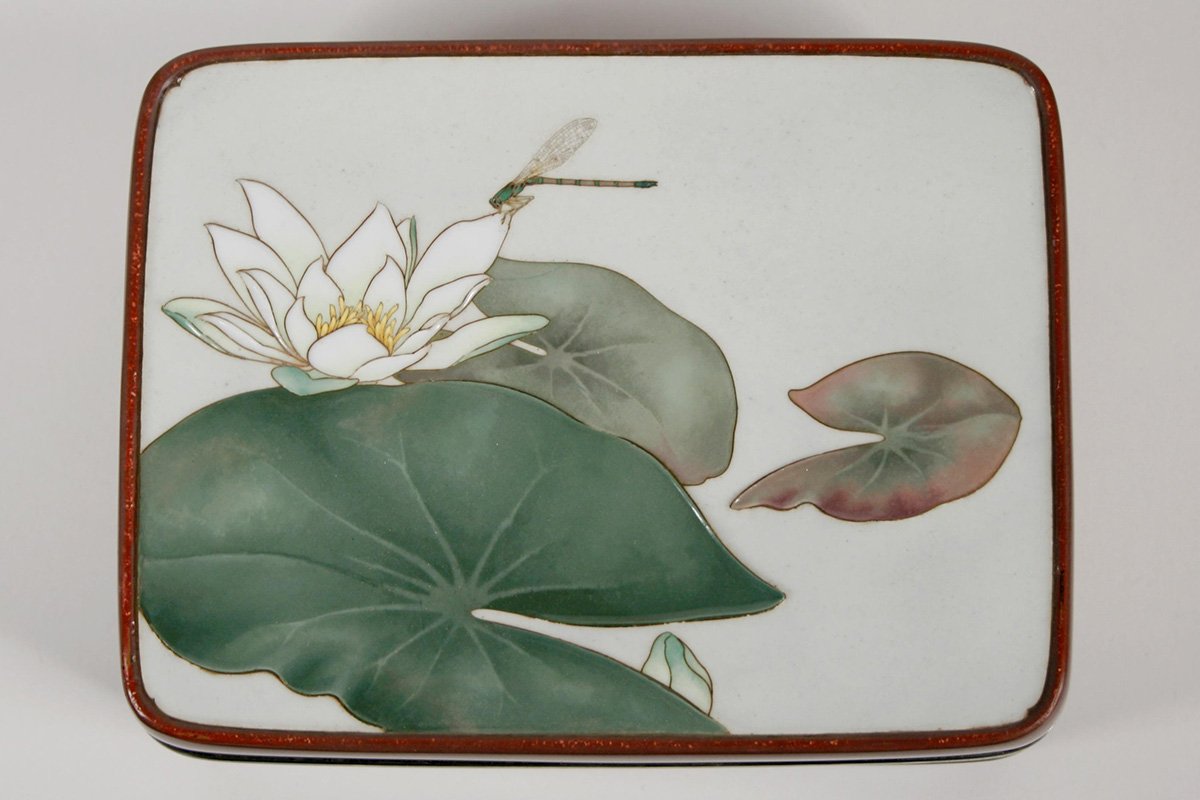MEIJI-TAISHO
HATTORI TADASABURO, MORIAGE ENAMEL WATER LILY & DRAGONFLY BOX
Kobako or incense box in a rectangular form, the lid ornamented in relief with a design of a dragonfly alighting on the petal of a white water lily, surrounded by three green and red-brown water lily pads and the pale tip of another flower bud, all against a pale grey-blue ground; the sides with grasses in mauve against a brown ground; the reverse of the lid decorated with the water lily stems and minnows against a pale grey ground, and the interior lined in brown and gold silk brocade figured with ginkgo leaves. Of cloisonné enamels on a bronze base, executed in moriage or relief technique, silver wired, and musen or wireless technique, with applied silver mounts. By Hattori Tadasaburo (active in Nagoya, late 19th – early 20th century). Late Meiji era, circa 1906 – 1907.
Included in the box is a hand written receipt in both black and red: Jisaku, Do Shippo Suiren Kobako Ikko, Hattori Tadasaburo or My Own Work, Bronze Cloisonné Water Lily (Design) Incense Box, One Piece, (by) Hattori Tadasaburo, and then: Baika Kin Ni-hyaku-en or Priced at 200 Gold Yen.
With a fitted and hinged, paulownia wood box, the interior lined in padded blue velvet, the exterior of the lid affixed with a number of inscribed paper labels: Shippo Suiren no Kobako or Cloisonné Incense Box (with a design of) Water Lilies. Then: Ni-ju-ichi Go or Number 21. Yon-ju Nen Choko Kai or (Exhibition of Works by the) Sculpture and Craft Art Association) in (Meiji) 40 (1907). Another label then reads: Goi…Juko no Uchi, Ni-ju-kyu Go, Shippo Suiren Kobako, Gokashi or One of a Set of (ten), Number 29 (a kura listing number), Cloisonné Incense Box (with a design of ) Water Lilies, A Gift (from the Imperial Family).
These labels combined with the receipt indicate that Hattori Tadasaburo exhibited this box in 1907, and it apparently sold at the exhibition for 200 Yen (then a substantial price) to either the Imperial Household Agency or a member of the Imperial family. Later it was given as an Imperial gift to the person whose kura or art storage warehouse label records the piece.
For other examples of Hattori Tadasaburo’s work in the Khalili Collection, c.f. Meiji no Takara: Treasures of Imperial Japan: Enamel, numbers 68 – 70. For another of his Imperial commissions, see also Barry Davies Oriental Art: Japanese Enamels of the Golden Age, number 16, a moriage vase with flowering hibiscus.
Thematically this masterpiece of cloisonné enameling illustrates the passing of mid into late summer. The water lily leaves have begun to turn color, and the dragonfly, ever a symbol of the evanescence of the season, delights in the last perfection of the blossom. On the sides, marsh grasses fence in the pond against a brown ground. The interior reveals seven minnows shadowed in the water amidst three water lily stems.
Hattori Tadasaburo, Moriage Enamel Water Lily & Dragonfly Box
Artist Name: Hattori Tadasaburo
Period: Meiji Taisho
Mediums: Enamel & Glass
Form: Ornamental Boxes
Origin Country: Japan
2 5/8” high x 6 ¾” x 5 ¼”
This piece is no longer available.





